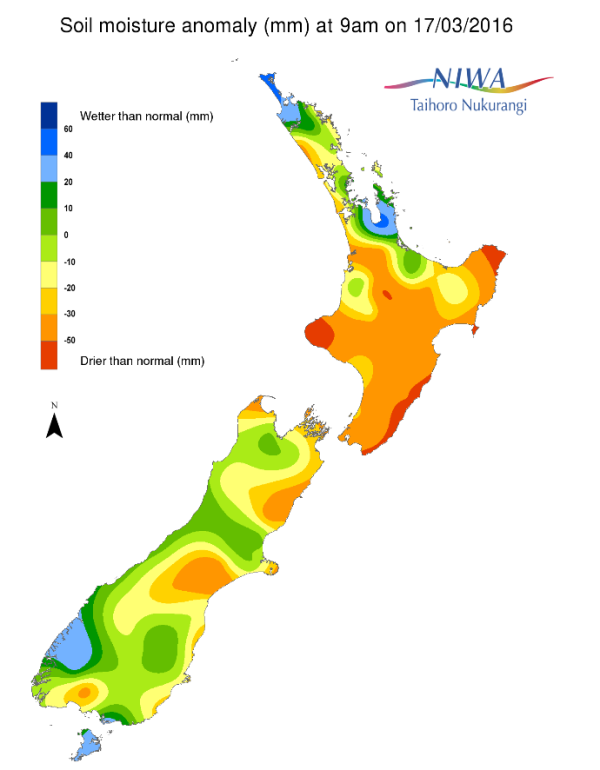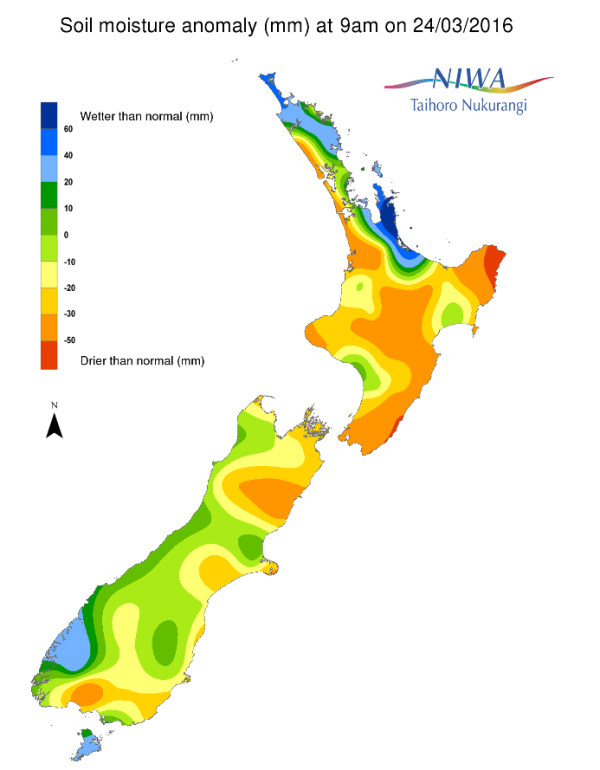A weekly update describing soil moisture across the country to help assess whether severely to extremely dry conditions are occurring or imminent. Regions experiencing these soil moisture deficits are deemed “hotspots”. Persistent hotspot regions have the potential to develop into drought.
Facts: Soil Moisture
Across the North Island, soil moisture levels have generally remained the same or increased when compared to this time last week. The most notable increases were observed on the Coromandel Peninsula and into the northwestern Bay of Plenty as well as Northland. Slighter increases occurred across the Central Plateau and from Taranaki to Wellington-Wairarapa including Manawatu-Whanganui. The wettest soils compared to normal for this time of the year are found along the Coromandel Peninsula and in northern Northland while the driest are found in Masterton and in far northeastern Gisborne.
Across the South Island, soil moisture levels have generally decreased slightly when compared to this time last week. The most notable decreases occurred in eastern Southland and southern Otago as well as northern Canterbury. The driest soils compared to normal for this time of the year are found in coastal Hurunui, Christchurch, and central Southland.
Outlook
An area of sub-tropical low pressure caused intense rain across much of the North Island from Wednesday into Thursday. While much of the western and northern North Island will turn drier in time for the start of the long weekend, showers and isolated thunderstorms will persist for the central and eastern parts on Friday. Rainfall may exceed 25 mm in the heaviest downpours from the Bay of Plenty to Hawke’s Bay, with daily amounts mostly less than 10 mm for the Central Plateau, eastern Manawatu-Whanganui, and Wellington-Wairarapa. The odd shower will affect Auckland and Northland Friday, leaving 5 mm or less. High pressure will build eastward toward New Zealand on Saturday, giving a dry day to many. Stubborn showers, especially early, may continue for the Central Plateau and from Gisborne to Wairarapa with falls generally less than 5 mm. Sunday and Monday look to have mainly dry conditions across the North Island, save the fleeting shower for the western and northern part. A push of southerlies may cause the return of shower activity to the east coast from Tuesday into Wednesday, though rain amounts are expected to be mostly light. Late in the week, a storm approaching from the west may leave those exposed to the north and west with the chance for rain; however, totals are not expected to be anything like those seen in recent days. Many places on the North Island may see near or below normal rainfall over the next week. The most likely exception is from Bay of Plenty to Hawke’s Bay, where rain early in the period may exceed the weekly normal.
Extremely heavy rainfall caused flooding across portions of Tasman and West Coast late Wednesday into Thursday. Storm total rainfall exceeded 250 mm in places. Lighter rain stretched across the Alps, reaching coastal central and northern Canterbury where it was more of a welcoming sight. The outlook over the next week, while not rain-free, is much less wet across the places on the South Island that experienced flooding. Friday, patchy rain is forecast to affect the West Coast with falls generally less than 10 mm. Much of the island will be rain-free on Saturday with high pressure stationed overhead. Changes will come Sunday as a frontal boundary brings the risk of rain to Fiordland, Southland, and Otago; daily falls may reach 25 mm in Fiordland but less than 10 mm elsewhere. Very light rainfall is possible for the West Coast across to lower Canterbury on Sunday night into Monday. Isolated showers may continue for the far south and West Coast from Monday into Tuesday but wetness will be the exception, not the rule. Meanwhile, much of the northern South Island will be experiencing a building streak of dryness. Wednesday is currently forecast to be dry for the whole of the South Island before an organized system may bring rain to the west and north to end the week. Much of the northern and eastern South Island may experience near or below normal rainfall over the next week. For the south and west, near normal rainfall is expected.
Soil Moisture
Much of the North Island has below normal soil moisture for this time of the year. Hotspot areas remain present across southern and western Hawke’s Bay, much of Wellington-Wairarapa, interior Manawatu-Whanganui, parts of Taranaki, central and northern Waikato, far southwestern Northland, northeastern Bay of Plenty, and northeast coastal Gisborne. Over the last week, hotspot activity has expanded to include parts of western Auckland. Hotspot relief is expected over the next couple of days from the Bay of Plenty to Hawke’s Bay. With mostly average or below average rainfall forecast through next week, hotspot areas may expand, especially in the far south, west, and north.
On the South Island, hotspot areas remain present in northern Canterbury and far northern Marlborough. A small hotspot has developed in central Southland and another in Christchurch. Over the next week, hotspot activity is forecast to worsen from mid Canterbury on northward. Hotspot activity may remain the same or worsen slightly in central Southland.
NB: due to the timing and reporting of daily 24 hour rainfall amounts (9 am each day) and time required to compute soil moisture deficit values, the rain that occurred on Thursday 24 March will not be fully reflected in the soil moisture anomaly maps until Friday 25 March.
Background
Hotspot Watch a weekly advisory service for New Zealand media. It provides soil moisture and precipitation measurements around the country to help assess whether extremely dry conditions are imminent.
Soil moisture deficit
The amount of water needed to bring the soil moisture content back to field capacity, which is the maximum amount of water the soil can hold.
Soil moisture anomaly
The difference between the historical normal soil moisture deficit (or surplus) for a given time of year and actual soil moisture deficits.
Definitions
“Extremely” and “severely” dry soils are based on a combination of the current soil moisture status and the difference from normal soil moisture (see soil moisture maps at https://www.niwa.co.nz/climate/nz-drought-monitor/droughtindicatormaps).


